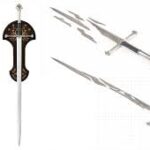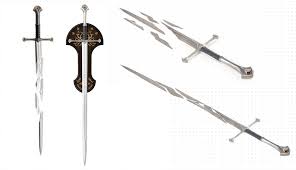In the world of The Lord of the Rings swords, few weapons are as iconic as Andúril and Narsil. These legendary swords, wielded by kings and warriors, hold deep historical and symbolic significance in Middle-earth. From the moment Narsil shattered in battle to its reforging into Andúril, the sword played a crucial role in shaping the fate of the realm. But how did Andúril evolve from Narsil, and what makes this weapon so special? Let’s explore the journey of this legendary blade.
The Origins of Narsil
The story of Narsil begins long before the events of The Lord of the Rings. Forged by the famed Dwarven smith Telchar of Nogrod, Narsil was an extraordinary sword known for its unparalleled craftsmanship and immense power. It eventually came into the possession of Elendil, the High King of Gondor and Arnor.
During the War of the Last Alliance, Elendil wielded Narsil against Sauron. However, in the final battle, Sauron struck Elendil down, breaking Narsil into pieces. But even in its broken state, the sword was still powerful—Isildur used its shards to cut the One Ring from Sauron’s hand, leading to the Dark Lord’s temporary defeat.
The Broken Shards and Their Legacy
After Isildur’s tragic death, the shards of Narsil were taken to Rivendell, where they were kept safe for generations. Though broken, they remained a symbol of the lost kingdom of Arnor and the hope that one day a true heir of Elendil would reclaim the throne.
For centuries, the Lord of the Rings swords played a symbolic role, reminding the people of Middle-earth of the lost glory of their kingdom. It wasn’t until Aragorn, the rightful heir of Isildur, came into possession of the shards that their true purpose was realized.
The Reforging of Narsil into Andúril
As Aragorn prepared for the final battle against Sauron, the Elves of Rivendell reforged the shards of Narsil into a new and even greater sword: Andúril, Flame of the West. The reforging symbolized Aragorn’s acceptance of his destiny and his readiness to reclaim the throne of Gondor.
The Andúril sword was not just a weapon; it was a beacon of hope for those fighting against the forces of darkness. With an Elvish inscription on its blade, it carried the legacy of the past while marking the beginning of a new era.
The Power and Symbolism of Andúril
Unlike Narsil, which had served primarily as a weapon of war, Andúril became a representation of kingship and the fulfillment of prophecy. The reforged sword was incredibly powerful, shining with an ethereal light and striking fear into the hearts of enemies.
Throughout The Lord of the Rings, Andúril played a crucial role in Aragorn’s journey. From leading the Dead Men of Dunharrow to commanding the armies of Gondor, Aragorn wielded Andúril with honor and determination. The sword’s presence alone was enough to rally forces and establish him as the rightful king.
Differences Between Andúril and Narsil
While Narsil and Andúril share the same lineage, they are distinct in several ways. Narsil was the sword of Elendil, shattered in battle but still carrying power in its shards. It represented the past and the fall of a great kingdom. On the other hand, Andúril was reforged from those shards, symbolizing renewal, prophecy, and Aragorn’s rightful place as king. Andúril was stronger, more refined, and imbued with greater significance, serving as a beacon of hope for Middle-earth.
The Legacy of Andúril
By the end of The Lord of the Rings, Andúril had become more than just a weapon—it was a symbol of Middle-earth’s restoration. As Aragorn ascended the throne, the sword remained by his side, marking the beginning of a new era of peace and unity.
Even beyond the books and films, the Andúril narsil continues to captivate fans of The Lord of the Rings. Whether through replica collectibles or adaptations in pop culture, this legendary weapon remains one of the most recognized Lord of the Rings swords of all time.
Conclusion
The journey from Narsil to Andúril is a testament to resilience, destiny, and the enduring power of hope. More than just a blade, Andúril symbolizes the rise of a king and the triumph of good over evil. Whether you are a dedicated fan or a newcomer to Middle-earth, the story of this legendary sword remains one of the most compelling elements of The Lord of the Rings.









